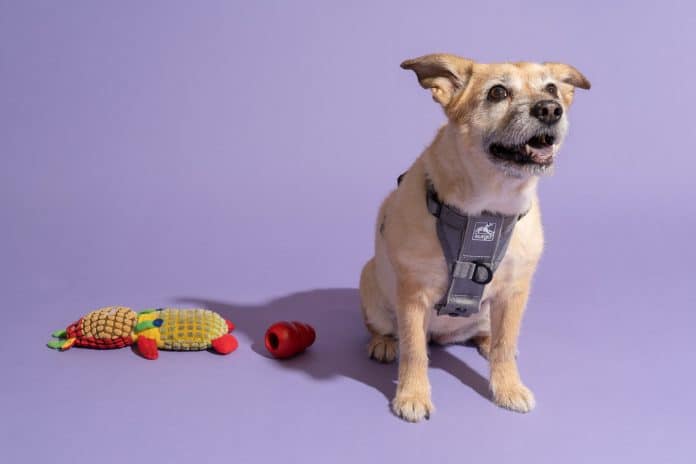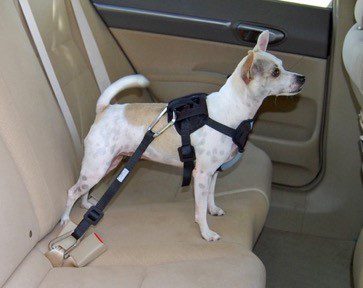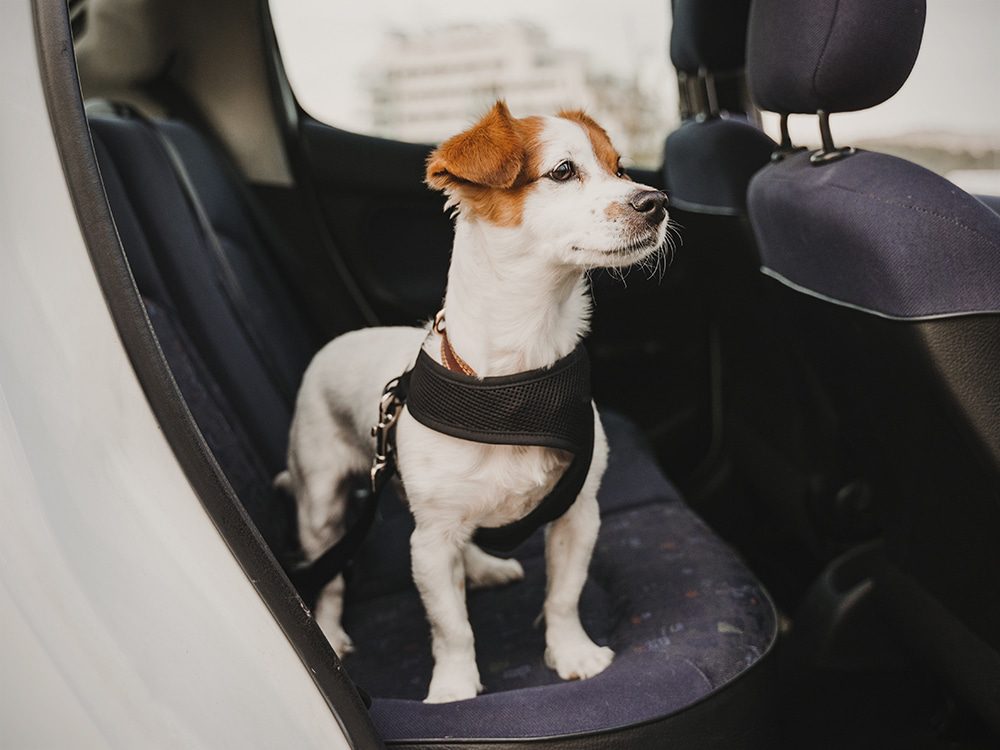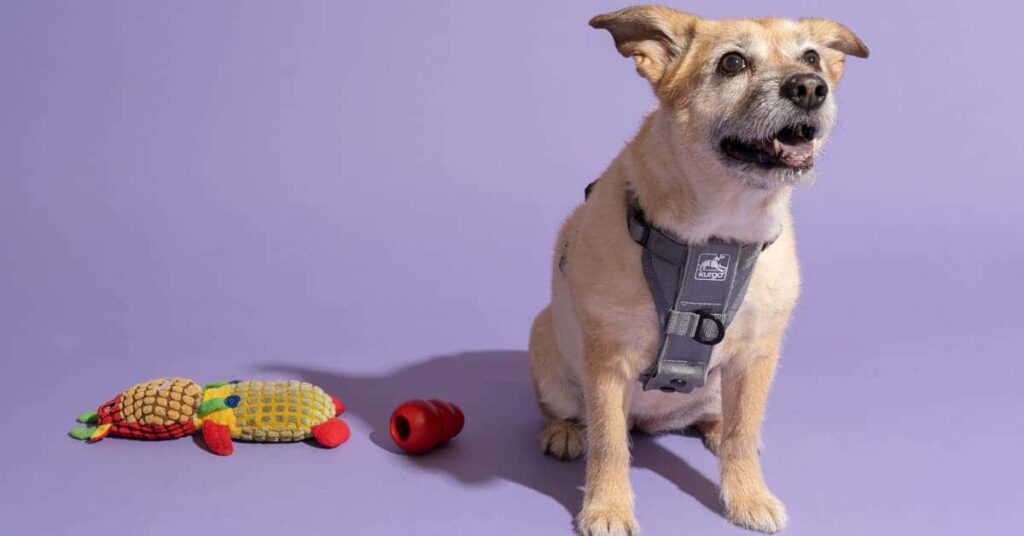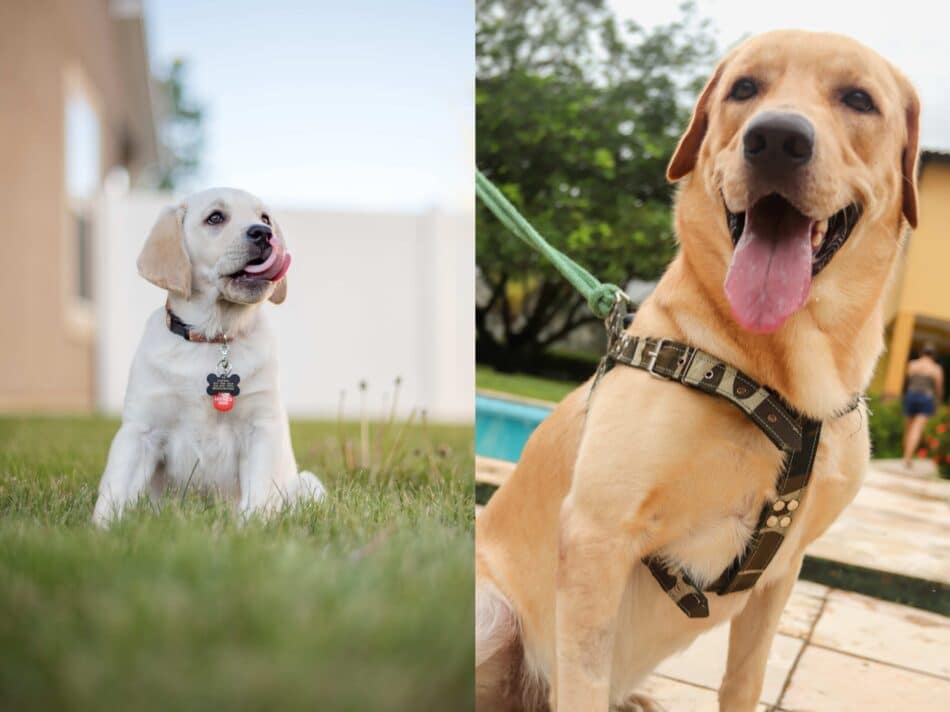Imagine walking your dog down the street, and they suddenly dart off in excitement at the sight of a squirrel. The tug on the leash leaves you feeling like you’re about to lose your balance. But what if there was a way to make your furry friend feel more secure and minimize the pulling? That’s where the question arises: Do dogs feel more secure with a harness on? In this article, we’ll explore the fascinating world of dog psychology and investigate whether a harness can truly provide our four-legged companions with a sense of security.
The Benefits of Using a Harness
Improved Control and Safety
Using a harness provides dog owners with improved control and safety when walking their furry friends. Unlike collars, which put pressure on the neck, harnesses distribute the pulling force across the shoulders and chest. This design allows for better control, especially for larger and stronger dogs. With a harness, we have a secure grip on our dogs, reducing the risk of them slipping out of our hands or escaping.
Reduces Neck and Spine Injuries
One of the major benefits of using a harness is the reduction of neck and spine injuries for dogs. Collars can put strain on the neck, particularly for dogs that pull on the leash. This strain can lead to discomfort, muscle strain, and even serious injuries. Harnesses, on the other hand, distribute the pressure evenly across the body, protecting the delicate neck and spine. By using a harness, we prioritize the physical well-being of our beloved pets.
Prevents Dogs from Escaping
Another advantage of using a harness is that it prevents dogs from escaping. Some dogs, especially those with a strong prey drive or a fear of certain stimuli, can easily slip out of collars. A properly fitted harness with secure buckles and straps ensures that our dogs cannot escape, giving us peace of mind during walks or outings. With a harness, we can confidently explore the world without the risk of our adventurous pups running off.
Ideal for Training Purposes
Harnesses are also ideal for training purposes. Whether we are starting to leash train our puppies or working on obedience commands, a harness can be a valuable training tool. The increased control and ability to redirect our dog’s movement make it easier for us to guide them and reinforce positive behaviors. Additionally, some harnesses are designed with attachment points for training aids, such as treat pouches or Clicker training tools, further enhancing our training sessions.
The Psychological Impact of Harnesses
Enhanced Feeling of Security
Using a harness can have a profound psychological impact on our dogs, enhancing their feeling of security. The snug fit of a harness provides a gentle embrace around their body, creating a sense of comfort and stability. This feeling of being held and supported can help alleviate anxiety and fear, especially in dogs that may have had negative experiences in the past. When our dogs feel secure, they are more likely to be relaxed and enjoy their time with us.
Reduces Anxiety and Fear
Harnesses can also help reduce anxiety and fear in dogs. The pressure distributed across the body by a harness can have a calming effect, similar to a comforting hug. This gentle pressure can help dogs feel grounded and more in control, alleviating their anxiety in stressful situations such as vet visits or crowded places. For dogs with noise phobias or separation anxiety, the added sense of security offered by a harness can be a valuable tool in managing their fears.
Sense of Comfort and Protection
Beyond feelings of security, harnesses provide our dogs with a sense of comfort and protection. The soft, padded materials used in harness construction provide a cozy and comfortable fit. This added layer of comfort can be especially beneficial for dogs with sensitive skin or those prone to chafing. Knowing they are protected and cared for can boost their overall well-being and strengthen the bond between us and our four-legged companions.
This image is property of s3-prod.dogtopia.com.
Factors to Consider in Choosing a Harness
Size and Fit
When choosing a harness, it is crucial to consider the size and fit of our dog. Harnesses come in various sizes, and ensuring the proper fit is essential for both comfort and safety. Measuring our dog’s chest girth and referring to the manufacturer’s size guide will help us determine the right size harness for our furry friend. A well-fitting harness should be snug but not too tight, allowing for comfortable movement while preventing any chance of slipping off.
Type of Harness
There are different types of harnesses available, including back clip, front clip, and head halters. Each type serves different purposes and suits different dogs’ needs. Back clip harnesses are the most commonly used and provide good control and distribution of pulling force. Front clip harnesses are ideal for dogs that tend to pull, as they redirect their attention towards us, promoting loose leash walking. Additionally, head halters can be effective for dogs that need more control during walks or have a tendency to lunge or jump.
Material and Durability
Considering the material and durability of a harness is important, as it affects both comfort and longevity. Soft and breathable materials such as nylon or padded fabric are popular choices, offering comfort without causing irritation. Additionally, durable materials ensure that the harness can withstand the wear and tear of daily use. Checking the stitching, buckles, and D-rings for strength and quality helps us choose a harness that will last and keep our dog comfortable.
Ease of Use
Choosing a harness that is easy to put on and take off is essential for both us and our dogs. Quick-release buckles and adjustable straps allow for hassle-free dressing, reducing stress for our furry friends. Additionally, harnesses with reflective or high-visibility features can make walks safer during low-light conditions. Considering our own comfort and convenience when selecting a harness will ensure that every walk is enjoyable for both us and our dogs.
Adaptability for Different Activities
If we plan on engaging in various activities with our dogs, such as hiking or swimming, considering the adaptability of a harness is crucial. Some harnesses are designed specifically for outdoor adventures and are equipped with features such as leash attachment points, carrying handles, or water-resistant materials. Choosing a versatile harness that can be easily adjusted or modified to accommodate different activities ensures that our dogs can join us in our adventures while staying safe and comfortable.
Understanding Canine Behavior and Reactions
Individual Differences in Preferences
Just like humans, dogs have individual preferences when it comes to wearing a harness. Some dogs may readily adjust to wearing one, while others may take time to feel comfortable. Observing and understanding our dog’s reactions and body language is essential in ensuring a positive experience. Paying attention to cues such as tail position, ear posture, or vocalizations can help us gauge their comfort level and make any necessary adjustments to the fit or style of harness.
Adapting to the Harness
Introducing a harness to our dogs gradually can aid in their adaptation. Starting with short sessions, allowing them to sniff and investigate the harness without any pressure, can help build positive associations. Gradually increasing the duration and eventually attaching the leash will allow them to acclimate to the sensation and presence of the harness. Using treats, praise, and gentle encouragement during the familiarization process will help our dogs feel more at ease and accepting of the harness.
Signs of Discomfort or Stress
It is crucial to be aware of signs of discomfort or stress when our dogs are wearing a harness. Common signs may include excessive panting, excessive scratching or pawing at the harness, freezing or avoiding movement, or attempting to remove the harness. If we notice any of these signs, it may indicate that the harness is causing discomfort or anxiety for our dogs. In such cases, it is essential to reassess the fit, adjust the harness if necessary, or consult with a professional trainer or veterinarian for guidance.
This image is property of i.insider.com.
Harness Training and Familiarization
Introducing the Harness Gradually
When introducing a harness to our dogs, it is important to start slowly and gradually. Familiarizing them with the harness in a positive and stress-free environment will ensure a smooth transition. Beginning with short sessions of simply holding the harness or allowing them to sniff it can help them associate the harness with positive experiences. Gradually progress to wearing the harness for short periods of time indoors, gradually building up to longer durations and outdoor walks.
Positive Reinforcement Techniques
Positive reinforcement is a crucial aspect of harness training. Rewarding our dogs with treats, praise, or play when they show positive behaviors associated with wearing the harness helps create positive associations. For example, giving treats and praising them when they voluntarily put their head through the harness, or when they walk calmly on the leash wearing the harness, reinforces the idea that wearing the harness leads to positive outcomes. Consistency and patience are key when using positive reinforcement techniques during harness training.
Creating Positive Associations
Creating positive associations with the harness involves making the overall experience enjoyable for our dogs. This can be achieved by incorporating fun activities, such as short walks to a park or playing their favorite game, immediately after putting on the harness. By doing so, we strengthen the positive connection between the harness and pleasant experiences. Making the process of putting on the harness a routine that precedes enjoyable activities helps our dogs view wearing the harness as a positive and exciting part of their daily routines.
Comparing Harnesses vs. Collars
Pressure and Restriction on the Neck
A significant difference between harnesses and collars is the pressure and restriction they place on the neck. While collars concentrate the force on the neck area, which can potentially cause injuries, harnesses distribute the force across the shoulders and chest. This even distribution reduces the risk of strain on the neck and minimizes potential harm to the delicate structures in that area. Harnesses are a kinder and gentler option for our dogs, prioritizing their comfort and well-being.
Potential for Injuries
Collars have a higher potential for causing injuries compared to harnesses. Dogs that pull or lunge on a collar can strain their neck muscles, leading to pain, discomfort, and potential injuries. On the other hand, harnesses offer a safer alternative, reducing the risk of injuries to the neck, spine, and throat. By choosing a harness, we prioritize the long-term health and safety of our dogs, ensuring that their adventures are free from unnecessary pain and discomfort.
Functionality and Control
While both harnesses and collars serve the purpose of controlling our dogs during walks, harnesses offer superior functionality and control. The attachment point on the back of a harness allows for better control, as it prevents our dogs from pulling us forward and encourages them to walk calmly beside us. This control is especially beneficial for dogs that are still learning leash manners or those with a tendency to pull. Harnesses provide us with the ability to redirect our dogs’ attention and guide their movement effectively.
This image is property of images.ctfassets.net.
Addressing Common Concerns
Restricting Movement and Freedom
One common concern with using a harness is the fear that it may restrict our dogs’ movement and freedom. However, when properly fitted, harnesses do not inhibit our dogs’ natural movements and allow them to walk, run, and play comfortably. In fact, harnesses can even enhance their freedom by providing us with better control and reducing the risk of them escaping or getting tangled in their leash. It is important to choose a harness that allows for a full range of motion and does not impede our dogs’ ability to move naturally.
Heat and Breathability
Another concern is the heat and breathability of a harness, especially during hot weather. It is important to select a harness made from breathable materials, such as mesh or lightweight fabrics, that allow for air circulation and prevent overheating. Additionally, choosing a harness with adjustable straps allows us to ensure a proper fit that is not too tight, further enhancing comfort and airflow. By considering the climate and our dog’s individual needs, we can choose a harness that keeps them comfortable and cool even in warm weather.
Weight and Restrictiveness
Some people worry that harnesses may be heavy or restrictive for their dogs, particularly smaller or more sensitive breeds. However, modern harness designs prioritize lightweight materials and ergonomic shapes to ensure comfort without sacrificing durability. By selecting a harness that is specifically designed for our dog’s size and breed, we can ensure that it is lightweight and non-restrictive. Taking the time to find a well-fitting harness that suits our dog’s individual needs will eliminate any concerns about weight or restrictiveness.
Considering Individual Dog Needs
Physical Health and Conditions
When choosing a harness, it is essential to consider our dog’s physical health and any pre-existing conditions they may have. Dogs with neck or tracheal issues, such as small breeds prone to collapsing trachea, may require a harness that does not put pressure on the neck area. Additionally, dogs with back or spinal problems may benefit from a harness that provides extra support or stability. Consulting with a veterinarian can help us determine the most suitable harness for our dog’s specific needs and ensure their comfort and well-being.
Behavioral Issues and Anxiety
Behavioral issues and anxiety can also influence the choice of harness for our dogs. Some dogs may have a fear of certain stimuli, such as other dogs or loud noises, which can trigger reactive behavior. For these dogs, a harness that allows for better control and redirection can be beneficial. Additionally, dogs with separation anxiety may benefit from a harness that provides a sense of security and comfort during walks or outings. Understanding our dog’s specific behavioral needs and seeking guidance from a professional trainer or behaviorist can help us choose the right harness to address their unique challenges.
Training History and Methods
Considering our dog’s training history and methods can also contribute to harness selection. Dogs that have been trained using positive reinforcement methods may respond well to a harness that allows for clear communication and redirection. Additionally, dogs that have a history of pulling or lunging may benefit from harnesses with front attachment points, which can discourage pulling and promote loose leash walking. Taking into account our dog’s training background and preferences will help us choose a harness that complements our training efforts and promotes positive behavior.
This image is property of cdn.thewirecutter.com.
The Importance of Proper Harness Fit
Measuring the Dog Correctly
Ensuring the proper fit of a harness is crucial for our dog’s comfort and safety. To measure our dog correctly, we need to take their chest girth measurement by wrapping a soft measuring tape around the widest part of their chest, just behind the front legs. This measurement will guide us in selecting the right size harness for our dog. It is important to refer to the manufacturer’s size guide and choose a harness that fits within the recommended measurements to ensure optimal fit and function.
Adjusting Straps and Buckles
Once we have chosen the appropriate size harness, it is important to adjust the straps and buckles to achieve a snug but comfortable fit. The straps should be tightened enough to prevent our dog from slipping out but not so tight that they restrict movement or cause discomfort. The harness should sit comfortably around the chest and shoulders without causing chafing or rubbing. Regularly checking and adjusting the straps and buckles as our dog grows or changes shape ensures that the harness continues to fit properly over time.
Checking for Comfort and Range of Motion
After properly fitting the harness, it is important to check for comfort and range of motion. Our dog should be able to move freely and comfortably while wearing the harness, without any restrictions or signs of discomfort. We can observe their movement during walks or playtime to ensure that the harness does not impede their natural gait or cause any irritation. Regularly checking for signs of discomfort, such as excessive scratching or pawing at the harness, allows us to address any issues promptly and make necessary adjustments for our dog’s comfort.
Consulting with a Veterinarian or Trainer
Seeking Professional Advice
For specific concerns or unique situations, consulting with a veterinarian or professional trainer is highly recommended. They can provide valuable insights and guidance in choosing the most suitable harness for our dog’s individual needs. Veterinarians can assess our dog’s physical health and recommend harness options that accommodate any existing conditions. Trainers can provide expert advice on selecting a harness that supports our training goals and addresses any behavioral challenges. By seeking professional advice, we can ensure that our choice of harness aligns with the best interests of our canine companions.
Tailoring to Specific Dog Breeds
Certain dog breeds may have specific physical or behavioral characteristics that warrant special considerations when selecting a harness. For example, brachycephalic breeds with shortened snouts require harnesses that do not put pressure on their respiratory systems. Small or toy breeds may benefit from harnesses that distribute pulling force across a larger area to minimize potential injury. Additionally, breeds with high prey drives or strong instinctual behaviors may require harnesses with additional control features. Tailoring the choice of harness to our dog’s breed-specific needs ensures their comfort and safety.
Addressing Specific Behavioral Concerns
Behavioral concerns such as fear, reactivity, or aggression may require specialized harnesses or equipment. Dogs with a tendency to lunge or pull may benefit from front-clip harnesses that redirect their attention towards us. Dogs with fear or anxiety may fare better with harnesses that provide a sense of security and comfort, such as wrap-style or vest harnesses. Addressing specific behavioral concerns in collaboration with a professional trainer can help us select a harness that supports our training goals and promotes positive behavior.
In conclusion, harnesses offer many benefits for both us and our dogs. The improved control and safety, reduced risk of injuries, and prevention of escapes make harnesses a valuable tool for any dog owner. The psychological impact of harnesses, including enhanced feelings of security, anxiety reduction, and comfort, contribute to our dogs’ overall well-being. When choosing a harness, it is important to consider factors such as size and fit, type of harness, material and durability, ease of use, and adaptability for different activities. Understanding canine behavior and reactions, harness training and familiarization, and comparing harnesses to collars further assist us in making informed decisions. By addressing common concerns, considering individual dog needs, ensuring proper harness fit, and consulting with professionals, we can select the right harness for our furry friends while promoting their comfort, safety, and happiness during walks and adventures.
This image is property of blog.omlet.co.uk.

